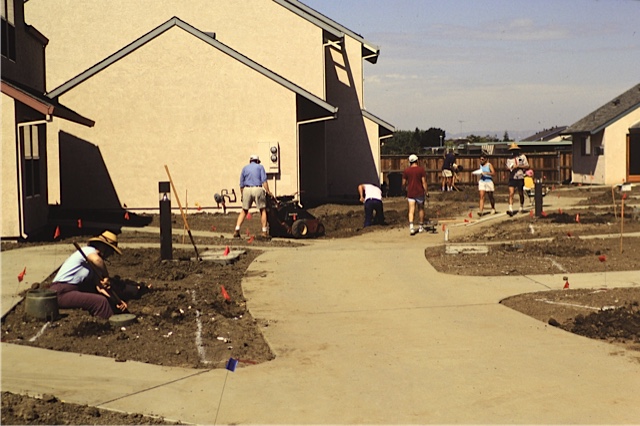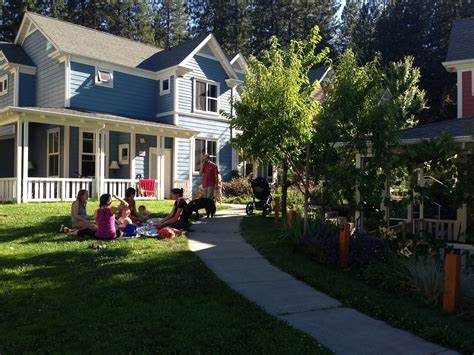An article shared by filmmaker John de Graaf
Architect Charles Durrett and filmmaker John de Graaf are working on a film that tells the cohousing story through cohousing residents first-person observations. Photo, Pamela Biery.
Charles Durrett may be the best kind of entrepreneur, offering a product designed to address some of the biggest problems we face in America. With the tireless zeal of a much-younger man, the 63-year old Nevada City, California architect is always on the move, selling a concept called “cohousing” to audiences across the United States. Tall and lanky, but slightly stooped by a back problem he has had since childhood, Durrett describes his product as “the best of both worlds.” “With cohousing,” he says, “you can have as much privacy as you want and as much community as you want, and it has a lot of other advantages as well.”
There are now more than 150 cohousing communities scattered across the American landscape, primarily in the western states. Durrett has been a designer of 50 of them. When he started promoting the idea, there were none. He and his former wife, Katie McCamant, met in the early 1980s at the University of Copenhagen, where they were both architectural students. They returned to the United States determined to help spread the cohousing concept (they coined the term), which the Danes had developed in 1972.
The concept is simple: groups of people come together to design their own community, which includes private dwellings (single homes, apartment complexes and townhouses), each self-sufficient if small, with their own kitchens. But a large “common house” serves the entire community. Meals are offered there to everyone several nights a week. The common house has its own kitchen, and often, various meeting rooms, recreation or exercise rooms, children’s playrooms and other amenities including games and books, and a couple of guest rooms for visitors.
Members of the community are expected to cook at least once a month and share other everyday maintenance chores. Cars are kept outside the main living area, allowing for safe open space for children. Decisions are made wherever possible by consensus. Residents can spend as much time with others in the common spaces as they choose, always with the nearby option of privacy in their own homes.
Durrett and McCamant were impressed by the joy and sense of social connection they witnessed in Danish co-housing communities. The idea was slow to catch on there initially, but after a Danish TV documentary explored the subject, the number of cohousing communities mushroomed. Now the country of five million people boasts 700 such communities.
Muir Commons in 1991. Muir Commons in Davis, California was America’s first Cohousing community. Photo by resident, Laurie Friedman.
MUIR COMMONS: AMERICA’S FIRST CO-HOUSING COMMUNITY
Back in the US, Durrett and McCamant started promoting cohousing with lectures and a handbook. Together with friends, they planned a cohousing community in Emeryville, California, near their home in Berkeley. They moved into it in 1992. But by then, another California city, its plan developed together with McCamant and Durrett, was already boasting a functional community. It was easier and quicker to get permits and loans for the project in Davis, a city known for its commitment to sustainability (and its Danish-like propensity for bicycling!), and Muir Commons Cohousing opened there in 1991.
I am currently producing a film on cohousing, featuring Durrett and four communities in the Sacramento area. With photographer Doug Stanley, of “America’s Deadliest Catch” fame, I visited Muir Commons recently. Two of the original residents, Jane McKendry and Laurie Friedman, showed us around. Old photos of Muir Commons under construction show a place devoid of trees and greenery, but after 28 years the homes are almost invisible behind the lush canopy of trees, shrubs and flowers that offers welcome shade in Davis’ steamy summer climate, where temperatures commonly hit 110 degrees. Lines of bicycles, the Davis staple, can be seen throughout the community. Jane and Laurie showed us the orchard, which provides fruit for the entire community, and the small but robust garden plot. And with her husband, Ray, Jane played a mean folk guitar for us; many residents, she said, have similar skills that they share freely with others.
The early Muir Commons rang with the voices of children, but there are fewer of them now because most of the original residents, happy with their living arrangements, have stayed put and are nearing retirement or older. Their kids have moved on. A lovely, tree-shaded children’s playground on the property sat empty while we were there. But new families will be coming, Jane said. In keeping with Davis’ environmentalism, Laurie showed us the shed filled with bicycles, and the parking lot outside the community. Many parking spaces include electric charging stations.
Nevada City Cohousing is a truly multi-generation community. Photo by Charles Durrett.
THE BENEFITS OF CO-HOUSING
From Muir Commons, we moved on to Nevada City’s Coho community, where Durrett and McCamant now live. Set on the edge of an impossibly charming Gold Rush town, it’s a beautiful village of pastel individual homes, a modern airy common house, and even a shared swimming pool. Flowers are everywhere. At Coho, many of co-housing’s benefits were clear. An array of solar panels heats all the homes and common space and produces a surplus of electricity for the power company, PG & E, keeping electricity bills low and sometimes even resulting in rebates. Children played happily in the pool, on the walkways and on the terrace of the common house. Several residents provided testimonials to the value of living there.
Stuart and Margaret Matthews family spoke of how there were numerous friendly neighbors to help look out for their two small children. Nancy Newman described the sense of support older residents received, especially at the passing of a spouse. Ingrid Holman, a single mother originally from Germany, told of the help she received in raising her 13-year old son, Christophe, who obliged us by masterfully playing “Pirates of the Caribbean” on the piano, and gushed eloquently about living in cohousing and having many friends so close by.
Interestingly, Ingrid first learned of cohousing ten years earlier when she picked up Robert Zeuner, an elderly man who was hitchhiking in the next-door town of Grass Valley. She offered to take him home and he told her he lived in the Nevada City cohousing community. She knew nothing about it but was intrigued—it seemed like something she might find in her native Europe—and Robert offered to show her around. Ingrid was hooked and found a rental in the community not long after. She’s been there ever since and is now buying her own place. Robert, meanwhile, lives right across from her, with his partner Bruce. They’ve become fast friends.
Coho boasts an attractive garden of vegetables and flowers, on the site of an abandoned hydraulic gold mine. Tony Finnerty, one of the gardeners, told us that the entire area was a maze of tall manzanita bushes and rocky ground when the community was built 15 years ago. The soil and compost had to be brought in. Signs in the garden let residents know when crops are ready and they are free to pick what they need. James, another resident, showed us the common workshop out by the parking lot, where he often crafts furniture. With such facilities, residents don’t need to own all their own tools, another cost-saving advantage of cohousing.
Conference room and library at McCamant & Durrett’s Nevada City office. Photo by Pamela Biery
SOCIAL CHANGE ARCHITECT
Doug and I visited with Chuck Durrett in his downtown Nevada City office, on the second floor of an old building dating to the 1800s. The office is small and filled with blueprints, artists’ conceptions of co-housing communities and the three-dimensional models Durrett loves. Christine Fantle, one of his assistant architects who also lives at Coho, showed me photos of many cohousing communities the firm had designed.
Durrett grew up in the nearby gold mining town of Downieville, a picture postcard village that attracts tourists as lamps do moths. He loved the feeling of growing up in a village where everyone knew everyone else, he says, and he’s found it again in cohousing. He bemoans the fact that when counterculture hippies discovered the Nevada City area in the late 1960s, they built their homes scattered all through the nearby woods. He remembers a Native American friend criticizing that pattern of settlement. “You white people build all over hell and back,” the friend told Durrett, “and you have no concept of the village.”
Cohousing offers a different model, much more sustainable than the counterculture’s, where people had to drive to get anywhere. Cohousing residents drive much less than typical Americans and use far fewer resources, especially water. And the Coho community is much safer from wildfires, a new normal in the age of climate change, than rural dwellers are.
But Durrett is clear: the biggest benefit of cohousing is that it offers community in an age of separation, when much of America suffers from loneliness and subsequent depression, often dangerously staved with opioids. This is particularly true for seniors, the fastest rising segment of the cohousing population in the US. Many senior co-housing communities are now being built. We visited one such community, Wolf Creek Lodge in neighboring Grass Valley, California. Like many cohousing villages, it has about 60 residents, but all are getting along in years.
Wolf Creek Lodge Senior Cohousing, Grass Valley, California.
SENIOR COHOUSING
When we were there, two couples were competing against each other in a lively game of petanque, a French sport much like bocce ball. Their neighbors sat on the steps of the common house, cheering them on. Durrett says seniors encourage each other to be active; in such communities it’s easy to find a partner to go walking with. It keeps everybody younger, and regular social contact with other residents provides an antidote for the chronic loneliness that a recent study showed 40 percent of senior Americans suffering from. Wolf Creek Lodge is an apartment-style complex with two wings radiating in a V from the common house. Every home has a porch where residents can look out at the neighbors, who they all know well, and shout out, “Hey, do you want to visit?”
Jacque Bromm, a youthful looking woman who loves to travel, showed us her beautiful apartment (more like a condo since she owns it) filled with memorabilia from her trips. Books about John Muir and the nearby Sierra Nevada mountains lay on her coffee table. Jacque loves the sense of community at Wolf Creek, but also the opportunity to travel knowing that neighbors will watch her home. Her friend, Casey Travis, a painter, uses her equally lovely apartment as a studio as well as a home. She says she gets lots of support for her artwork from other residents, who have many special talents of their own to share.
Wolf Creek residents are giving back to the town of Grass Valley, helping its parks’ department construct a trail down to and along the nearby burbling creek. We walked down 200 steep steps to the creek with Bob Branstrom, a resident and project leader. Eventually, switchbacks and pavement will make the trail accessible to all of the seniors in the community, even those in wheelchairs.
THE FUTURE
At the end of our trip, we went with Charles Durrett to Fair Oaks, a Sacramento suburb, where a new community of townhouses is being built. We visited with a young couple, Andrew May and Rachel Yamada, who are excited about moving in (with daughter, Freya and Rachel’s mother), to the home they were watching being built. It’s one of many cohousing communities now under construction, but Durrett wants there to be a lot more, and as soon as possible. He’s excited by many of the new communities, including one in American Canyon, California full of small houses for homeless veterans. Durrett is deeply interested in ways to make cohousing more affordable for the poor and to increase diversity of all kinds. Many cohousing residents are activists with a liberal bent, but after a visit to new project in Stillwater, Oklahoma Durrett says conservatives are taken with the idea as well.
He’s not Pollyannaish about it, however. Cohousing isn’t for everyone. You have to be willing to work with others, compromise, and, especially, listen to each other, sometimes during long meetings. That was the hardest part for Durrett to get used to, having grown up like the rest of us in an individualistic culture where if you don’t like something you just walk away. “I’ve come to realize that other people have some good ideas too,” he says with a smile. Some people never adapt to the consensus approach and drop out, but the attrition rate is dramatically less than that of other American communities. The great majority of residents stay on, happily. Creating a cohousing community can be tough in other ways. Groups looking to establish a community may quarrel over what land to purchase and some, especially in areas where the idea is new, may wait a long time for city permits and bank loans.
But the trend is distinctly positive and establishing the communities is getting easier. Charles Durrett and Katie McCamant saw the future in Denmark in 1980. Cohousing’s offer of community as well as privacy, has proven immensely popular and offers a way out of the lonely, unsustainable housing patterns that have for too long been the norm in American life.
John de Graaf has produced dozens of award-winning documentaries including the PBS hit, Affluenza. He is currently directing The Best of Both Worlds, a short film about co-housing.
You can support this film by visiting www.gofundme.com/cohousing-film and making a tax-deductible contribution.
Muir Commons Cohousing in Davis California today. Photo by Laurie Friedman.






